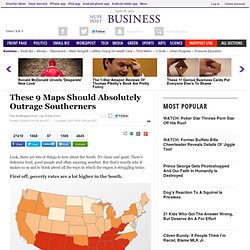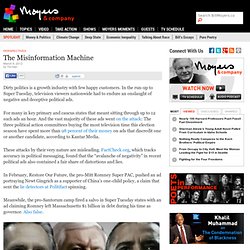

These 9 Maps Should Absolutely Outrage Southerners. Look, there are lots of things to love about the South.

It's clean and quiet. There's delicious food, good people and often amazing weather. But that's exactly why it makes us so sad to think about all the ways in which the region is struggling today. First off, poverty rates are a lot higher in the South. Source: USDA In fact, as many as one in four Southern kids lives in poverty, compared to the national average of one in five. In the map above, red shading indicates a poverty rates between 17.9 and 22.8 percent. And minimum wages are much lower.
Source: Department Of Labor Virtually no Southern states, with the exception of Florida, have a minimum wage higher than the federal floor of $7.25 an hour. And people living in the South are a lot less likely to move up the economic ladder. Source: Equality Of Opportunity Project If you want to achieve the American Dream, don't move to the South. Many living in poverty in the South are being denied access to affordable health care. Source: CDC. America’s angriest white men: Up close with racism, rage and Southern supremacy. Who are the white supremacists?

There has been no formal survey, for obvious reasons, but there are several noticeable patterns. Geographically, they come from America’s heartland—small towns, rural cities, swelling suburban sprawl outside larger Sunbelt cities. These aren’t the prosperous towns, but the single-story working-class exurbs that stretch for what feels like forever in the corridor between Long Beach and San Diego (not the San Fernando Valley), or along the southern tier of Pennsylvania, or spread all through the Upper Peninsula of Michigan, across the vast high plains of eastern Washington and Oregon, through Idaho and Montana. America’s angriest white men: Up close with racism, rage and Southern supremacy. The Misinformation Machine. Dirty politics is a growth industry with few happy customers.

In the run-up to Super Tuesday, television viewers nationwide had to endure an onslaught of negative and deceptive political ads. For many in key primary and caucus states that meant sitting through up to 12 such ads an hour. And the vast majority of these ads went on the attack: The three political action committees buying the most television time this election season have spent more than 98 percent of their money on ads that discredit one or another candidate, according to Kantar Media.
These attacks by their very nature are misleading. FactCheck.org, which tracks accuracy in political messaging, found that the “avalanche of negativity” in recent political ads also contained a fair share of distortions and lies. In February, Restore Our Future, the pro-Mitt Romney Super PAC, pushed an ad portraying Newt Gingrich as a supporter of China’s one-child policy, a claim that sent the lie detectors at Politifact spinning.
Stoprush [licensed for non-commercial use only] / FrontPage. The Art of the Filthy Rich. Gary McCoy Political Cartoons – Political Humor, Jokes, and Pictures Updated Daily - Sunday, March 4, 2012 - 97012. Gary McCoy was born in 1962 and developed a lifelong love of cartooning alongside his younger brother, Glenn.

For 14 years, Gary worked as the editorial cartoonist for the Suburban Journals of Greater St. Louis. His work on Illinois state-issues was distributed by Copley News Service, and has been reprinted in The Washington Post, as well as some textbooks. Southern Poverty Law Center Hate Group report: Obama election triggers "patriot" organization. Rush Fake Apology. Mickey Mantle: Photographs, on and off the field, from LIFE Magazine. Many baseball scouts called the young Mickey Mantle the most talented prospect they’d ever seen, and he justified their confidence in his abilities on the field and at the plate by reaching the big leagues in 1951 when he was just 19.

The next season, at 20, he replaced Joe DiMaggio as the Yankees’ center fielder and finished third in the MVP voting. The story of Mantle’s “arc” — from gullible country boy to big city superstar to faded, injury-ravaged icon playing out his last games as a shadow of his former, formidable self — has been told countless times. Here, LIFE presents a quick tour through The Mick’s life, on the field and off, in hopes of providing a glimpse into why one player won the hearts of so many fans across so many years . . . and what the lineaments of an athlete’s life can look like when the stands empty and the fans go home. Mantle stood 5′ 11″ and weighed roughly 200 lbs. his whole career, but he packed prodigious power into that frame.